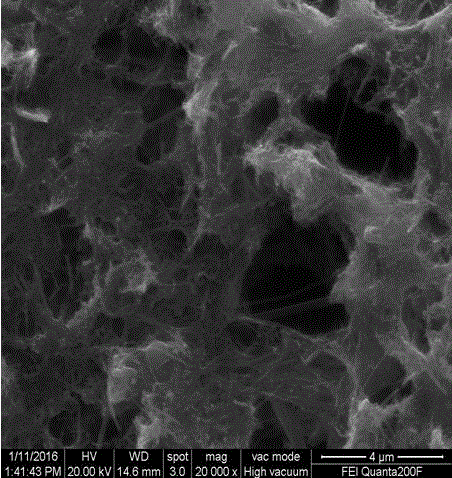Method for preparing lithium-sulfur battery by taking graphitized carbon nanotube flexible film as current collector of lithium-sulfur battery
A lithium-sulfur battery, graphitized carbon technology, applied in battery electrodes, electrode carriers/current collectors, circuits, etc., can solve problems such as poor conductivity, shedding, and impact on battery life
- Summary
- Abstract
- Description
- Claims
- Application Information
AI Technical Summary
Problems solved by technology
Method used
Image
Examples
Embodiment 1
[0022] (1) Take 100g of carbon nanotubes, heat it in the graphitization furnace at 2300°C for 20h, and take it out.
[0023] (2) The carbon nanotubes are ball milled at 300r / min for 3h to a fine and compact powder.
[0024] (3) Using NMP as the solvent and carbon nanotubes (CNTs) as the basic material, the mass ratio of CNTs:PVDF:SDS is 91:5:4, the solid content is adjusted to 4%, the high-speed shearing is 2h, and the pulp is made.
[0025] (4) Choose aluminum foil as the base material, take 10ml of slurry, and coat it into 5x8cm 2 The area is dried at 50℃ to form a film.
[0026] (5) Soak the aluminum foil module in the hydrochloric acid solution for 24 hours to completely corrode the substrate, and take it out carefully to dry.
[0027] (6) Carbonize the prepared CNTs film at 900°C, graphitize it at 2300°C, and take it out for rolling. And after carbonization and graphitization, the impurity content is low, and the crystallinity of CNTs is improved.
[0028] (7) The mass ratio is sul...
Embodiment 2
[0031] (1) Take 100g of carbon nanotubes, keep them in a graphitization furnace at 3000°C for 16h, and take them out.
[0032] (2) The carbon nanotubes are ball milled at 200r / min for 6h to a fine and compact powder.
[0033] (3) Using ethanol as the solvent and carbon nanotubes (CNTs) as the basic material, the mass ratio of CNTs:PVDF:SDBS is 96:2:2, the solid content is adjusted to 2%, the high-speed shear is 1h, and the pulp is made.
[0034] (4) Choose copper foil as the base material, take 10ml of slurry, and coat it into 5x8cm 2 The area is dried at 50℃ to form a film.
[0035] (5) Soak the copper foil module in a concentrated nitric acid solution for 10 hours to completely corrode the substrate, and take it out carefully to dry.
[0036] (6) The prepared CNTs film is carbonized at 1000°C, graphitized at 3000°C, and taken out and compacted. And after carbonization and graphitization, the impurity content is low, and the crystallinity of CNTs is improved.
[0037] (7) The mass rati...
PUM
 Login to View More
Login to View More Abstract
Description
Claims
Application Information
 Login to View More
Login to View More - R&D
- Intellectual Property
- Life Sciences
- Materials
- Tech Scout
- Unparalleled Data Quality
- Higher Quality Content
- 60% Fewer Hallucinations
Browse by: Latest US Patents, China's latest patents, Technical Efficacy Thesaurus, Application Domain, Technology Topic, Popular Technical Reports.
© 2025 PatSnap. All rights reserved.Legal|Privacy policy|Modern Slavery Act Transparency Statement|Sitemap|About US| Contact US: help@patsnap.com

